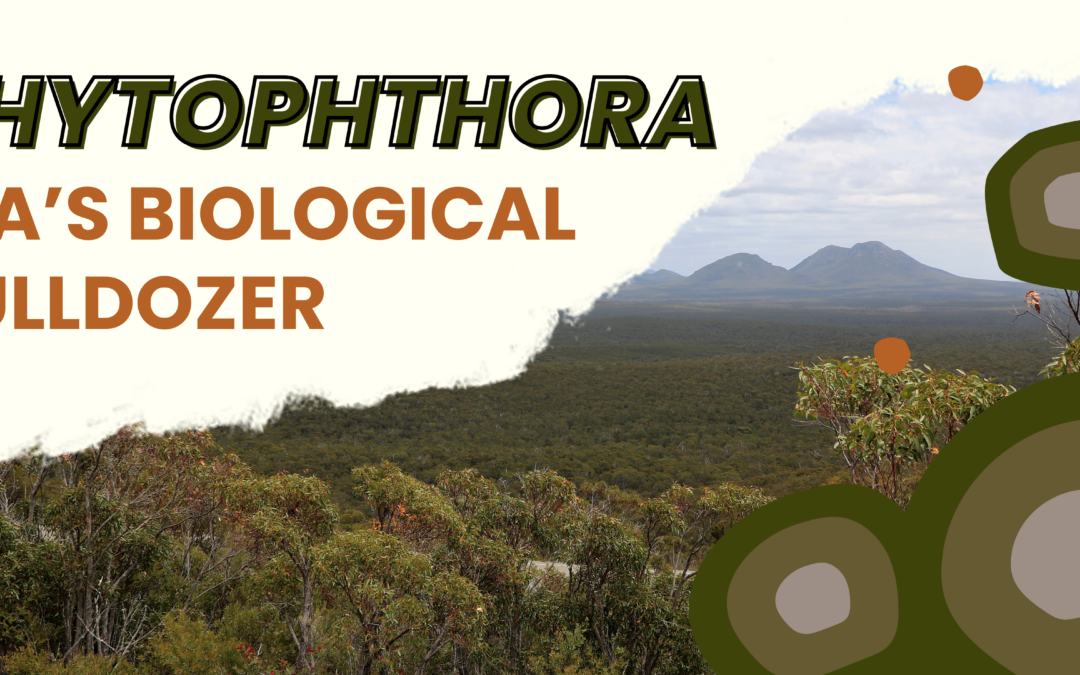The name Phytophthora comes from the Greek meaning “plant destroyer”. Sadly, this is a pretty accurate description of what this plant pathogen is doing to native vegetation across the southwest of Western Australia.
Phytophthora dieback is a highly destructive plant disease impacting native vegetation across Australia. More than 60 species of Phytophthora are found across the country (Burgess, et al., 2017). Phytophthora cinnamomi is generally considered the most destructive and is listed as one of the world’s worst invasive species (Lowe, et al., 2000).
The impacts of this disease are widespread. The loss of native vegetation can affect animals that rely on plants for food and habitat, agriculture production, as well as social and cultural values. In most cases, these impacts are irreversible, so careful management is required to minimise the spread of this disease.
What is it?
Historically, Phytophthora was believed to be a fungus, but it is now understood to be closer in relation to algae and is considered to be a water mould (Figure 1). The pathogen thrives in mild conditions and wet soils as it is briefly mobile in water (DCCEEW, 2018).
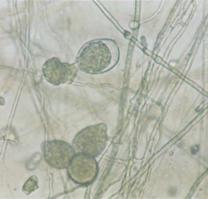
(Skzuta, n.d.)
The pathogen affects different species in different ways. Being soil-borne, it always attacks the roots first, but on some tree species, it will cause lethal stem cankers or infect leaves (Hansen, 2015). The pathogen will limit water uptake in plants, so symptoms are usually similar to water stress (DCCEEW, 2014).
Where is it a problem?
Phytophthora dieback is a serious problem in all Australian states and territories except the Northern Territory (DCCEEW, 2018). Within Western Australia, there is a ‘vulnerable zone’ (Figure 2) where conditions are particularly suitable for the disease to spread. This zone stretches across the southwest part of the state, where rainfall exceeds 800mm per year. Areas receiving more than 400mm of rainfall may also be at risk (DWG, 2000).
Within this vulnerable zone alone, around 40% of native flora species are susceptible to infection, which equates to around 2284 different plant species (Shearer, et al., 2004). This is particularly devastating as this region of southwest WA is internationally recognised as rich in biodiversity and endemism.
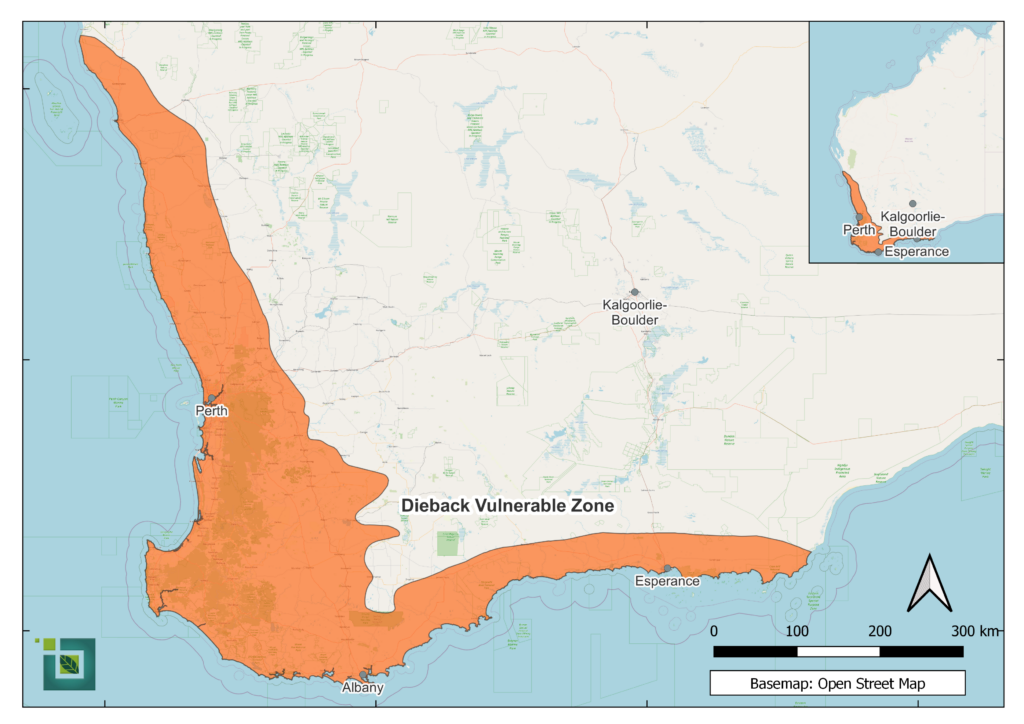
Although this pathogen targets flora species, it can have a knock-on effect to fauna. The pathogen threatens flowering plant species which are important to animals that feed on nectar. WA’s beloved honey possum has been found to favour taller, denser and more diverse habitats (Dundas, et al., 2016), meaning they could avoid landscapes affected by Phytophthora. Bird community compositions have also been found to vary between diseased and healthy woodlands in southwest WA (Davis, et al., 2014).
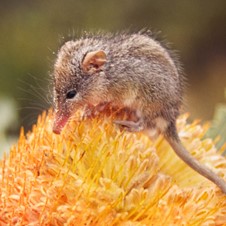
(Bush Heritage Australia, 2024)
How did it get here?
Some of the Phytophthora species recorded in Australia are likely native. However, Phytophthora cinnamomi, the most destructive species, was introduced. This species is believed to have come from Papua New Guinea, although it is now found around the world.
This species was first identified in the Jarrah Forests of WA in the 1960s (DCCEEW, 2018). It was likely introduced to Australia on plants brought over by European settlers (O’Gara, et al., 2005).
How is it spread?
Phytophthora is spread through soil movement. Naturally, this would occur through runoff and via animals. However, humans have unarguably caused the rapid spread across WA and Australia.
Humans spread the pathogen by moving soil as it sticks to shoes, vehicles and equipment. This is a problem when infected areas are used for recreation, but industrial uses are one of the most significant risks for spread. Mining, especially of basic raw materials that are unprocessed before use, poses a significant risk, and dieback has commonly been witnessed alongside associated sites (DWG, 2021). Dieback management should, therefore, be considered at these sites in vulnerable areas.
How should it be managed?
Given that Phytophthora cinnamomi has been found to survive in moist soil for up to six years without a host (Zentmyer & Mircetich, 1966), once a site is infected, it can be incredibly difficult to treat effectively. The focus is often, therefore, on management measures to limit the spread. The Dieback Working Group were established in WA to increase awareness of Phytophthora dieback and share knowledge on management and best practice measures (DWG, 2024).
On-ground management often focuses on limiting the spread. Dieback Management Plans need to be in place at high-risk sites, such as recreation areas or mines within the vulnerable zone. Management Plans should prioritise limiting access as human activity is known to accelerate the spread.
Where access is required, management should focus on good hygiene practices. A ‘clean on entry’ approach should always be adopted. Where soil may be moved, machines, vehicles, footwear, and any other equipment may be carried to be cleaned of mud, clods, slurry or soil (DBCA, 2023). This is critical before entering an authorised dieback-free zone or when moving between infected areas. DBCA provides hygiene inspection checklists, which should be adhered to when machinery and vehicles move from these sites.
Education is also an important tool. Education may range from appropriate signage to formal training. For commercial operations, especially within State Forests or Conservation Areas, staff accessing the site must be adequately trained. Green Card Training is a WA-authorised course to educate work on biosecurity and hygiene (Dieback Working Group, 2024).
DBCA and the Dieback Working Group have many useful resources, guidance and templates available to improve awareness and manage the spread of dieback.
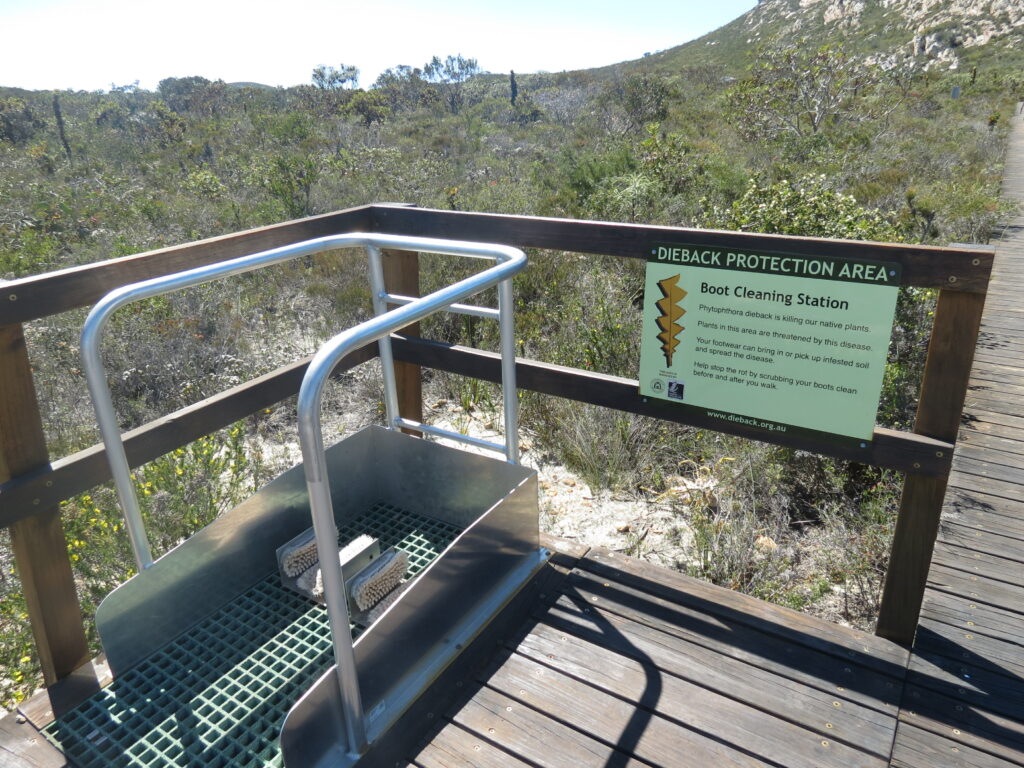
Treating infected sites
Where the disease already occurs at a site, there is very little that can be done to eradicate it. To minimise the impact, the State’s current focus is on the use of phosphite, a chemical that is often sprayed aerially (DBCA, 2023). The State’s phosphite application is focused on high-priority flora and ecological communities that are at high risk, such as the Stirling Range, Busselton Ironstone Threatened Ecological Communities and Eastern Stirling Range Montane Heath and Thicket TECs (DBCA, 2023).
New and novel control and eradication methods are being investigated, but to date, no treatment has been effective to prevent infection at scale. Limiting the spread remains our best hope of protecting susceptible flora in WA.
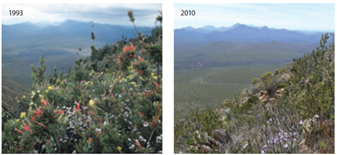
(DCCEEW, 2014)
Regulation
Phytophthora dieback is listed as a key threatening process under the Environment Protection and Biodiversity Conservation Act 1999. Under the Act, the Commonwealth Government were required to develop a National Threat Abatement Plan. Within WA, this plan is implemented by the Department of Biodiversity, Conservation and Attractions (DBCA) under the Conservation and Land Management Act 1984. The DBCA have obligations to manage disease spread on Crown-managed parks and reserves.
Phytophthora dieback on private or leased land in the vulnerable zone is managed via approvals processes, including environmental impact assessment (EIA). Proposed activities that may spread dieback will be subject to relevant approvals. EIA processes under the Environment Protection Act 1986, such as Part IV assessments, Native Vegetation Clearing Permits and works approvals, will consider the threat of dieback spread as a part of the assessment. If approved, proposals will have conditions attached, such as the requirement for a Dieback Management Plan. Similarly, exploration mining lease holders in this area are required to submit a Dieback Management Plan in their Programmes of Work.
Ignorance of the law is not an excuse, as causing unauthorised environmental harm can be an offence under the Environmental Protection Act 1986.
Integrate Sustainability has a diverse team with experience in Phytophthora management, approval requirements and assessment facilitation. If you are planning activities within a dieback zone and need assistance understanding requirements or complying with obligations, please get in touch with us at enquiries@integratesustainability.com.au or call us on 0894 680 338.
References
Burgess, T., White , D., McDougall, K. M. & Garnas, J., 2017. Distribution and diversity of Phytophthora across Australia. Pacific Conservation Biology, 23(1), pp. 1-13.
Bush Heritage Australia, 2024. Honey Possums. [Online]
Available at: https://www.bushheritage.org.au/species/honey-possum
Davis, R. A. et al., 2014. Impact of Phytophthora-dieback on birds in Banksia woodlands in south west Western Australia. Biological Conservation, Volume 171, pp. 136-144.
DBCA, 2023. Dieback Hygiene. [Online]
Available at: https://www.dbca.wa.gov.au/management/threat-management/plant-diseases/phytophthora-dieback/dieback-hygiene
[Accessed 07 03 2024].
DBCA, 2023. Phosphite and Phytophthora dieback. [Online]
Available at: https://www.dbca.wa.gov.au/management/threat-management/plant-diseases/phytophthora-dieback/phosphite-and-phytophthora-dieback
[Accessed 13 03 2024].
DBCA, 2023. Phosphite and Phytophthora dieback – the use of phosphite to slow the spread and impact of Phytophthora dieback. [Online]
Available at: https://www.dbca.wa.gov.au/management/threat-management/plant-diseases/phytophthora-dieback/phosphite-and-phytophthora-dieback
[Accessed 07 03 2024].
DBCA, 2024. Phytopthora dieback. [Online]
Available at: https://www.dbca.wa.gov.au/management/threat-management/plant-diseases/phytophthora-dieback#:~:text=In%20WA’s%20south%2Dwest%20bioregion,(grass%2Dtrees)%20families.
[Accessed 06 03 2024].
DCCEEW, 2014. Threat abatement plan for disease in natural ecosystems caused by Phytophthora cinnamomi, s.l.: Australian Government.
DCCEEW, 2018. Background document: Threat abatement plan for disease in natural ecosystems caused by Phytophthora cinnamomi, Canberra: Australian Government.
Dieback Working Group, 2024. Green Card Training. [Online]
Available at: https://www.dwg.org.au/green-card-training/
[Accessed 07 03 2024].
Dundas, S. J., Hardy, G. E. S. J. & Fleming, P. A., 2016. The plant pathogen Phytophthora cinnamomi influences habitat use by the obligate nectarivore honey possum (Tarsipes rostratus). Australian Journal of Zoology, 64(2), pp. 122-131.
DWG, 2000. Phytophthora dieback guidelines for local Government., Western Australia: Dieback Working Group.
DWG, 2021. Best Practice Guidelines for Management of Phytophthora Dieback in the Basic Raw Materials Industries, s.l.: s.n.
DWG, 2024. Who are the DWG?. [Online]
Available at: https://www.dwg.org.au/about-dwg/about-dieback-working-group/
[Accessed 19 03 2024].
Hansen, E. M., 2015. Phytophthora species emerging as pathogens of forest trees. Forest Pathology and Entomology, Volume 1, pp. 16-24.
Lowe, S., Browne, M., Boudjelas, S. & De Poorter, M., 2000. 100 of the World’s Worst Invasive Alien Species – A Selection From The Global Invasive Species Database, Auckland: The Invasive Species Specialist Group.
O’Gara, E., Howard, K., Wilson, B. & Hardy, G. E. S. J., 2005. Management of Phytophthora cinnamomi for biodiversity conservation in Australia: Part 2 National best practice guidelines, Perth: Murdoch University .
Shearer, B. L., Crane, C. E. & Cochrane, A., 2004. Quantification of the susceptibility of the native flora of the South-West Botanical Province, Western Australia, to Phytophthora cinnamomi. Australian Journal of Botany, 52(4), pp. 435-443.
Skzuta, G., n.d. [Online]
Available at: https://www.researchgate.net/figure/Zoosporangia-of-Phytophthora-cinnamomi-and-released-zoospores-Phot-G-Szkuta_fig1_273020178
[Accessed 08 03 2024].
Zentmyer, G. A. & Mircetich, S. M., 1966. Saprophytism and persistence in soil by Phytophthora cinnamomi. Phytopathology, Volume 56, pp. 710-712.

